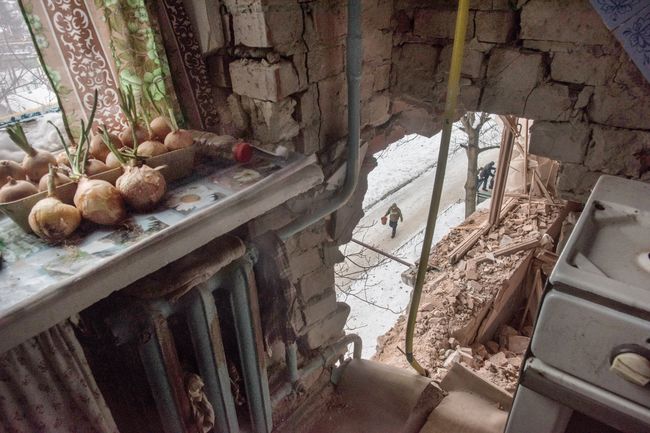Onion and emptiness
The Den photography exhibit at Kyiv’s Lavra gallery displays a lot of works about war: portraits of veterans, battlefield photos, and pictures of ruins
What is etched on you memory out of the latter is Yevhen Malolietka’s Avdiivka, February 2017.
The picture was taken inside a ruined house. You can see a street and passersby through the broken wall and floor. There is a small fridge on the right and the smashed furniture deep in the room. No wealth at all. There is a windowsill edge on the left and a germinating onion on it.
No one knows who lived here, whether the mortar shell that hit their storey touched them, whether they were at home at that moment.
The onion on the windowsill germinates little by little, letting out green shoots. It may have been put there just for this purpose – to cut off and crumble the sprouts into salad. Or, maybe, they planned not to get it sprouted but peel and put it into soup. We’ll never know this, for there is nobody to make that soup and salad.
War is an interrupted routine which suddenly turns out to be the greatest imaginable value, a tremendous and longed-for dream, a sweet plaintive recollection – a customary schedule of the day, humdrum daily chores, minor woes and penny-worth victories, stores and marketplaces, honking cars and children playing on the sidewalk, the gossiping neighbors and pigeons by the window, rain and sun flashes on the window panes, onions and potatoes, dawns and dusks, silence and wind.
What is there no more,
What you can’t bring back,
Emptiness all around.
“ASCENT IS THE CENTRAL THEME”
Natalia ISHCHENKO, political scientist, media expert:
“It is very important that, although the event occurring in a belligerent state, there still are photographers and other people who prepared this exhibit. They managed to find a light at the end of the tunnel. I have noticed that hope and renewal is the key theme this year. And the ascent, the rehabilitation of ATO soldiers, is also the central theme. All the other works seem to be rallying around it. Moreover, even the military photographs are optimistic and warm. The warmth this exhibit exudes is perhaps the brightest impression.”
“EVERYTHING IS VERY PROFESSIONAL AND, AT THE SAME TIME, HEARTFELT”
Iryna DERKACH, exhibit participant, Kharkiv:
“I work as photographer at the Kharkiv Art Museum and participating in the competition for the first time. An artist, who likes photojournalism very much and has submitted his works to the Den contest, persuaded me to do so.
“My photograph shows an old woman who sells lemons. This means my lens ‘caught this exhibit’s trend’ [we chose ‘golden lime’ as the color of the exhibit. – Ed.]. The picture demonstrates that old age is in no way carefree in this country. People are paid small pensions and have to work in order to survive. The theme is very complicated and the photo is cheerless, although it was taken in a seemingly peaceful life. Yet there are also some positive photos, especially the ones that show children – sincere, ingenuous, and smiling. I also liked some strong series full of deep sense.
“I was impressed with the scale and harmony of the exposition. It’s wonderful that the newspaper provides informational support to its exhibit, particularly by means of the glossy Route No. 1. Everything is very professional and, at the same time, heartfelt. It’s very good that this photo competition doesn’t such thing as banal decoration of three winners. Impartiality and a large number of winners is a key moment at this contest. The newspaper’s partners and friends choose what they like and give pleasant gifts to the authors. And it always pleases photographers to see their works noticed and decorated.”
“A DIFFICULT BUT NECESSARY REMINDER”
Anastasia PUHACH, spokesperson, Kyiv International Molodist Festival:
“The photographs displayed at the exhibit remain deeply etched on my heart. I think the most important pictures are those from eastern Ukraine. I am a migrant from Donetsk, where my kin have remained behind, so I know what’s going on there. But very few people in peaceful cities like Kyiv think about the terrible things that happen there, about the people who die there.
“It is hard to watch the pictures of burials, ruined buildings and infrastructure. I saw some of this with my own eyes, for example, the mental hospital in Semenivka. What also struck me are photos by Yevhen Malolietka who I know personally. He often comes to the ATO zone. His and his colleagues’ pictures are a hard but necessary reminder which keeps from forgetting about the war in a peaceful city.
“Yet there are also pictures that cheer you up. A boy who copies the monument to tourist in Kamianets-Podilskyi, a child who hops over the puddles, a happy elderly couple in love, and poppy field – these photos remind us that we have extremely beautiful people and landscapes.
“My special thanks to editors for witty and satirical political photos – both in the newspapers and at the exhibit. It’s nice that one can display photos of the current or former presidents with ironic captions or from a funny angle and that everybody is free to see and discuss it.”
Interviewed by Daria TRAPEZNIKOVA, Maria CHADIUK, The Day
Newspaper output №:
№66, (2017)Section
Time Out





